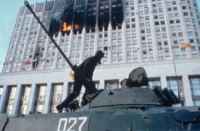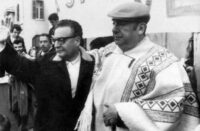■ Paul O’Brien, Seán O’Casey: Political Activist and Writer, Cork University Press, 2023, €39.
Paul O’Brien has published a political biography of Seán O’Casey, looking at the dramatist from a broadly left-wing viewpoint. The book is accessibly written and sheds light on details of working-class Dublin and international history.
O’Brien’s interest in Irish labour history is evident in his informative account of late nineteenth and early twentieth-century Dublin working-class life and events, following O’Casey’s development and the context from which arose his plays. Into this fall the writer’s involvement with the Irish-language and nationalist movement.
O’Casey joined the Irish Republican Brotherhood in 1905 and was later instrumental in the establishment of the Irish Citizen Army, which he left before the 1916 Rising.
O’Casey’s defining experience had been the Great Lockout of 1913, and much space is rightly devoted to his trade union activism and to Jim Larkin. Less space is spared for the fellow-leader of the Lockout, James Connolly, with whom O’Casey broke. O’Brien sheds some light on this disagreement, concentrating on O’Casey’s position, who gave priority to the class struggle above the struggle for national liberation, which required an alliance with the class enemy.
Here it could have been useful to outline Connolly’s stance on an anti-imperialist alliance in a little more detail for balance. Where O’Casey shows part of the truth as he sees it, the reader would benefit from the full picture.
This breach was significant in relation to the position O’Casey took on the 1916 Rising and subsequently, informing his three early Dublin plays, each of which examines momentous events concerned with the struggle for independence.
O’Casey did not accurately reflect the degree of working-class involvement in 1916. A significant proportion of the forces of both the Irish Citizen Army and the Irish Volunteers were working-class people, who identified with and fought for the vision of the proclamation of a democratic republic: “We declare the right of the people of Ireland to the ownership of Ireland and to the unfettered control of Irish destinies, to be sovereign and indefeasible.”
O’Brien’s extensive reading and knowledge of drama and the arts is reflected throughout the book and kindles the reader’s interest in the development of working-class drama, from which grew the first working-class dramatist of international standing writing in English. The chapter entitled “The New Drama” provides much detail and a sense of the times that produced this drama as well as the importance attached to cultural expression and playwriting by the revolutionary working class.
The author’s refreshingly wide awareness of European theatre is evident in his presentation of O’Casey in the context of the left-wing European playwrights of the 1920s and 30s, Brecht and Toller, but also Denis Johnston in Britain and the wave of expressionism that characterised the era.
O’Brien is similarly well versed in the history of the Abbey Theatre and O’Casey’s struggle for his plays to be performed there, and his relationship with W. B. Yeats and Augusta Gregory, as well as his final resignation and departure for England when The Silver Tassie was rejected.
While O’Brien devotes most space to discussions of the Dublin tragedies, he is cognisant of O’Casey’s later plays and brings them into the study, setting each in its time, introducing and discussing them in relation to the writer’s outlook. O’Casey’s canon beyond the Dublin trilogy is little known in Ireland and the anglophone world; his fantastic mature plays have rarely if ever been performed here. This is in contrast to the socialist countries, where O’Casey was a standard part of the repertoire and known mainly for his later work. In the German Democratic Republic (East Germany), O’Casey was one of the most frequently staged Western dramatists. O’Brien creates an interest in these later plays and presents their artistic as well as political merit.
O’Casey, writing at almost eighty, affirmed: “I am still a Republican, a Communist, and, in a way, a member of the Gaelic League.”¹ O’Brien relates that O’Casey had been approached by the Irish Workers’ League to support the future general secretary of the Communist Party of Ireland, Michael O’Riordan, in the May 1951 general election. Though O’Casey replied saying his endorsement would damage O’Riordan’s chances, and that he would instead donate towards the fund, his affirmation of O’Riordan in the same letter was used in the election leaflet.²
Robert Lowery states: “His ardent enthusiasm and life-long adulation for the USSR, which he considered one of the world’s greatest human experiments in creating a society of a new type, deserves primacy in evaluating his socialist legacy.”³
O’Brien states that his purpose is to concentrate “on a political reading of O’Casey on his terms,”⁴ and he does this for large sections of the book. He departs from this approach when discussing the dramatist’s position as a lifelong supporter of the communist movement and the Soviet Union, where his own position takes precedence over O’Casey’s. When this context arises, O’Casey is associated exclusively with the term “Stalinism,” and any differences with the Communist Party of Great Britain are highlighted and praised.
Seán O’Casey: Political Activist and Writer is an interesting, informative and enjoyable read and a valuable addition to the canon of O’Casey commentary. It is far more than a book of academic criticism, although it is that too.
1. David Krause, The Letters of Sean O’Casey, vol. 3, p. 642 (3 November 1958).
2. O’Brien, ••• p. 251.
3. Robert Lowery, “The socialist legacy of Sean O’Casey”, The Crane Bag, vol. 7, no. 1, Socialism & Culture (1983), p. 128.
4. O’Brien, •••p. 4.






